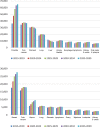Future projection of cancer patients with cardiovascular disease in Japan by the year 2039: a pilot study
- PMID: 30903421
- PMCID: PMC6597732
- DOI: 10.1007/s10147-019-01426-w
Future projection of cancer patients with cardiovascular disease in Japan by the year 2039: a pilot study
Erratum in
-
Correction to: Future projection of cancer patients with cardiovascular disease in Japan by the year 2039: a pilot study.Int J Clin Oncol. 2019 Aug;24(8):995. doi: 10.1007/s10147-019-01444-8. Int J Clin Oncol. 2019. PMID: 31011914 Free PMC article.
Abstract
Background: The number of cancer patients in Japan is estimated to rise to 3.5 million by 2025. The disease burden may be further complicated by comorbidities caused by cardiovascular disease (CVD). Predicting the number of cancer patients with CVD can help anticipate future resource needs.
Methods: We used statistics derived from the Niigata Cancer Center CVD Study (2015) as well as population estimates from the National Cancer Center's Cancer Registry and Statistics survey of 2017 for convenience. We simply multiplied the projected number of cancer patients through the year 2039 by the CVD prevalence in 2015, with patients classified by sex, age, and cancer type to estimate the number of cancer patients with CVD.
Results: The total number of Japanese cancer patients with CVD was 253,000 in 2015 and is predicted to increase rapidly by 30,000 in 2020 and peak at 313,000 in 2030-2034. Men will dominate the CVD population at 2.5-fold the number of women. The growth rate of the population with both cancer and CVD will be greater than that of the cancer-only population (1.23 vs 1.18, P < 0.001), and will comprise notably high proportions of patients with prostatic, breast, and uterine cancers (1.80, 1.57, and 1.66, P < 0.001, respectively).
Conclusion: Future cancer patients will be older and more likely to have CVD. Although men will continue to dominate this population, the increase in the number of women will be pronounced. Cancer care providers should be trained to recognize CVD and provide any necessary interventions concurrently with cancer therapy.
Keywords: Cancer; Cardiovascular disease; Comorbidity; Epidemiology; Prediction models.
Conflict of interest statement
No author has any conflict of interest.
Figures





References
-
- American Cancer Society Cancer Facts & Figs (2017) (2017). American Cancer Society. Atlanta. https://www.cancer.org/research/cancer-facts-statistics/all-cancer-facts.... Accessed 25 Dec 2018
-
- Mortality by cause of death. Statistics Bureau, Ministry of internal affairs and communications. http://www.stat.go.jp/data/sekai/0116.htm#c14. Accessed 25 Dec 2018
-
- Cancer Registry and Statistics. Cancer Information Service, National Cancer Center, Japan. https://ganjoho.jp/reg_stat/statistics/stat/index.html Accessed 25 Dec 2018
-
- Edwards BK, Noone AM, Mariotto AB, et al. Annual Report to the Nation on the status of cancer, 1975–2010, featuring prevalence of comorbidity and impact on survival among persons with lung, colorectal, breast, or prostate cancer. Cancer. 2014;120:1290–1314. doi: 10.1002/cncr.28509. - DOI - PMC - PubMed
MeSH terms
LinkOut - more resources
Full Text Sources

